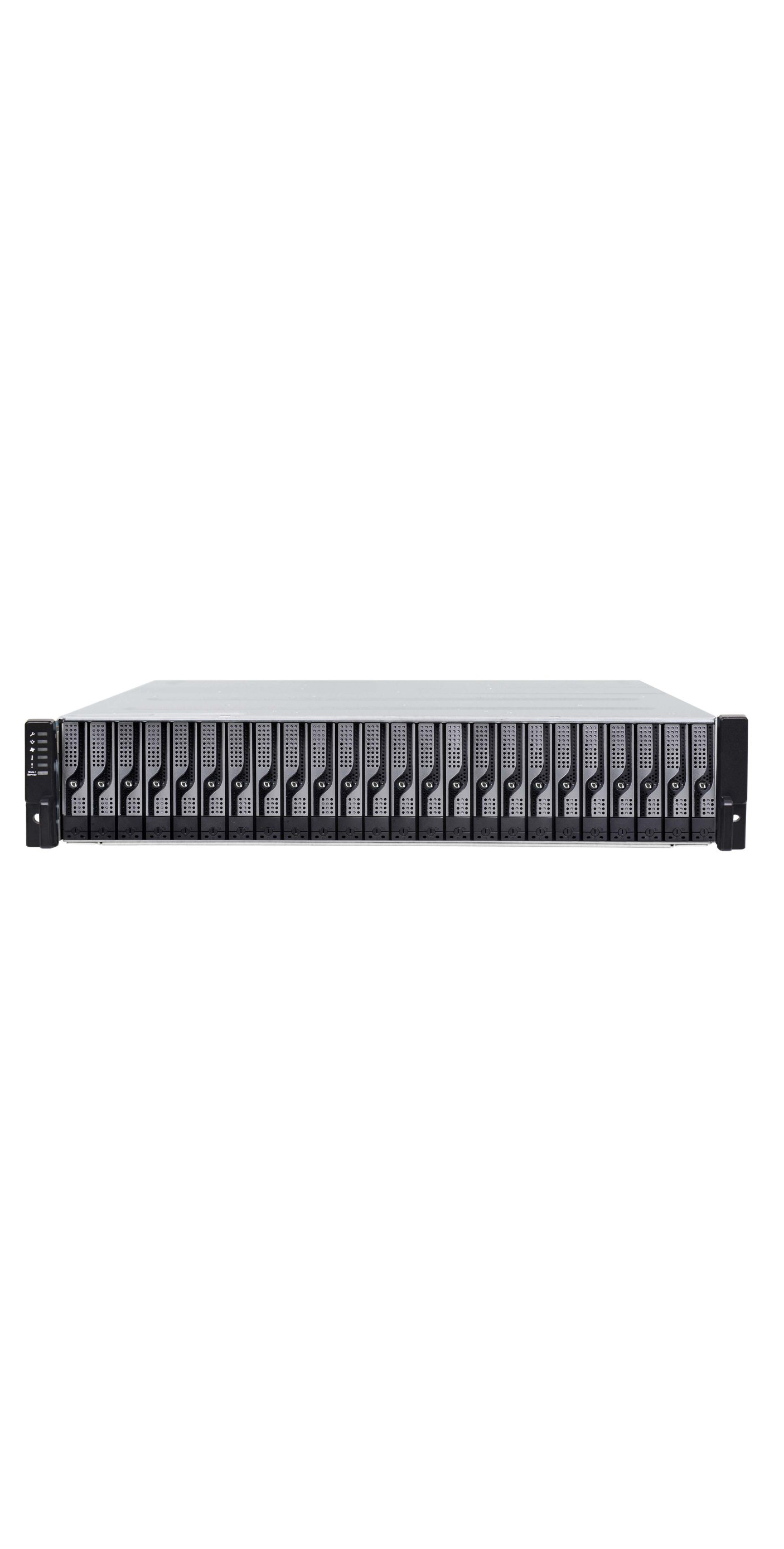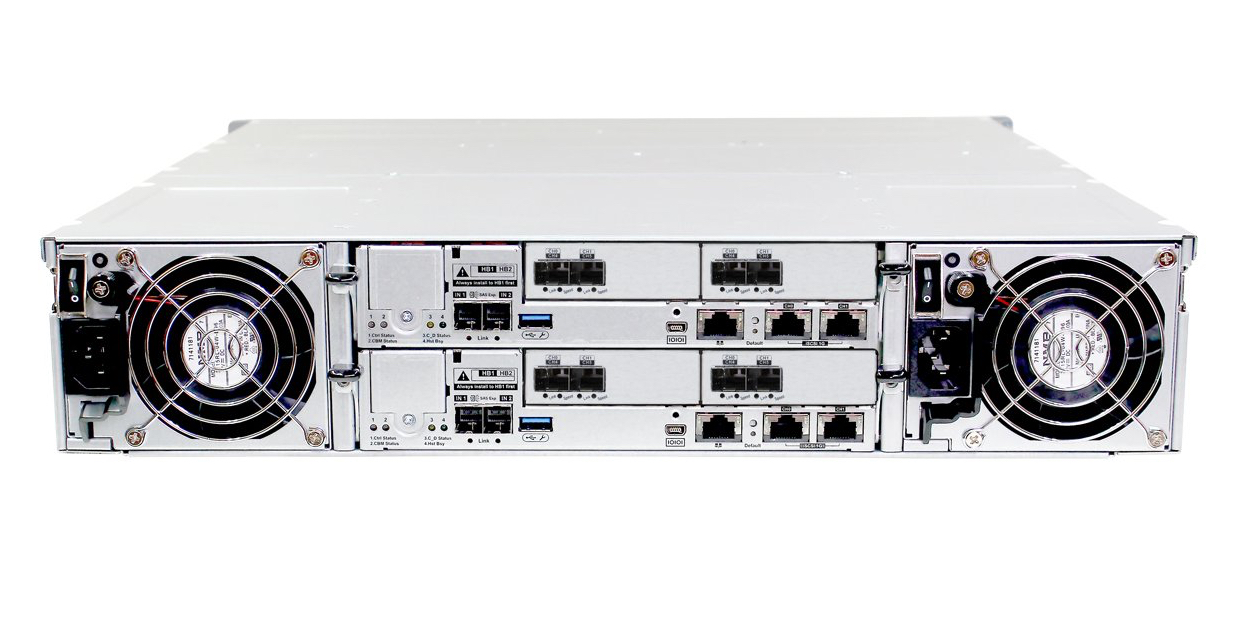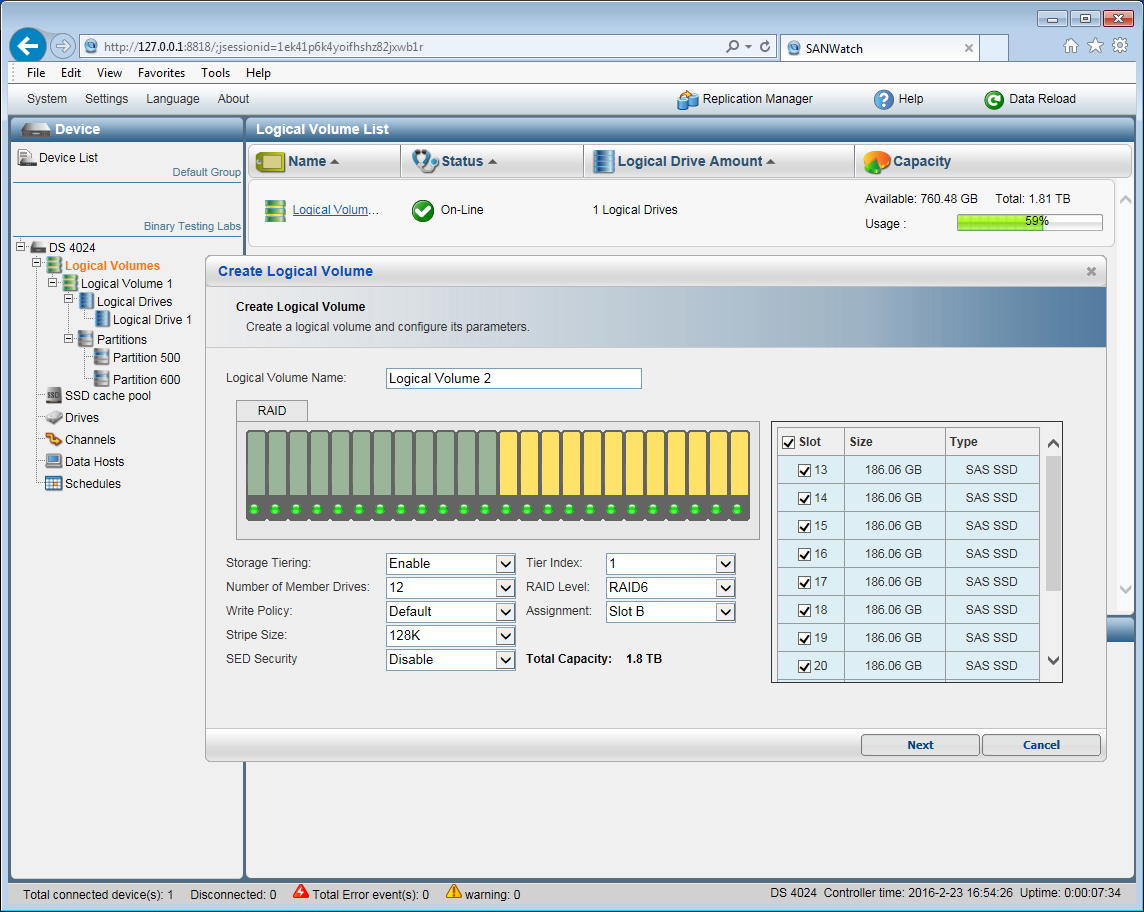Infortrend EonStor DS4024RUCB review
Incredibly versatile 100% SSD fibre channel storage arrays are already here


Its fine blend of features and amazing all-flash performance makes this storage array a top value choice for storage hungry businesses
-
+
Top performance; Wide choice of host ports; Good value; Massive expansion potential
-
-
Manual data tiering; User guides need improving

Choice has always been a big feature of Infortrend's EonStor storage arrays and the latest DS 4000 Series has it by the bucketful. These use hybrid controllers supporting four host board options allowing you to choose from 10GbE iSCSI, 8/16Gbps FC, 10GbE FCoE and 12Gbps SAS-3.
The new modular controllers include dual 1GbE iSCSI ports and have room for two host boards. There's more as the controller's 2.2GHz Xeon D-1500 SoC supports DDR4 cache, the standard 8GB can be boosted to a whopping 256GB and it's protected by a fast-charging capacitor.
Snapshots, volume copies and volume mirrors are included in the price while optional data tiering supports up to four storage tiers where hot data is kept at the top for the best performance. Remote replication is also an option as is the new SSD cache feature which uses up to four SSDs per controller to accelerate random read access.
On test is the DS4024RUCB 24-bay model which Infortrend supplied with a full house of 200GB Toshiba SAS-3 eMLC SSDs along. There are dual controllers, each with four 16Gbps FC ports. Expansion potential is staggering as the controllers have dual SAS-3 ports and support up to 444 drives using Infortrend's 16, 24 and 60-bay disk shelves.

Controllers and MPIO
In dual controller arrays, both are active and all host ports are available. However, if you use them for creating redundant links over multi-path I/O (MPIO) links, the path to the secondary controller functions as a standby link and its bandwidth is not aggregated with the primary link.
When you create a logical drive, you assign either controller A or B as its primary one. Essentially, the port on the secondary controller only comes into play if the primary port fails.
This gives you more choice as you can create multiple virtual volumes and use either controller as their primary link. It's also possible to create aggregated MPIO links simply by mapping volumes to multiple ports on the same controller.
For Windows Server 2012 R2, avoid Infortrend's EonPath software and only use Microsoft's DSM for MPIO links. The muddled and outdated user manual fails to mention this and we found that EonPath doesn't provide options to choose MPIO policies such as round robin or weighted paths.
Easy storage provisioning
Deployment is a piece of cake as we used the array's RAIDWatch web console to create two RAID6 logical drives each with 12 SSDs and assigned one to Controller A and the other to B. Within the drives, we created partitions of varying sizes and mapped them to selected FC ports.

Drives are placed in logical volumes with an appropriate RAID level assigned
RAIDWatch only provides basic access to storage services so you'll need to use the SANWatch app to manage snapshots, volume copies, replication and data tiering. Its interface is very similar to the RAIDWatch console so it's easy to use and its home page provides a useful array of performance graphs.

Partition snapshots can be scheduled regularly - as often as every 5 minutes
The price includes a standard snapshot license supporting 64 per volume and 128 per system which can be taken manually or scheduled as often as every 5 minutes. Rollback is fast as we recovered deleted data from a partition in 30 seconds although it did have to be unmapped first.
SSD caches and tiering
As our review system was fully populated by SSDs there was nothing to be gained from the SSD cache feature. For arrays using standard hard disks, you install SSDs in the head unit only and place them in the cache after which the array automatically moves frequently accessed data to them.
For data tiering, you have a 2-tier license costing a one-off fee of 1,899 with a 4-tier license increasing this to 2,999. To use it, you create separate logical drives, enable tiering and assign each a priority from 0 to 3 where Tier 0 would comprise fast SSDs.
Sadly, data tiering doesn't occur in real-time so you must run on-demand or scheduled migration jobs from SANWatch. Scheduled jobs can be run as often as once a day and move blocks to the appropriate tier based on usage.

Different drives can be placed in up to four tiers based on their performance and capacity
Stratospheric performance
To test Infortrend's bold performance claims, we used four Xeon E5-2600 servers running Windows Server 2012 R2 and all equipped with Emulex LightPulse dual-port 16Gbps FC adapters.
We created four partitions and mapped each one to two ports on the same controller so we could create 32Gbps MPIO links. Using Iometer, we recorded around 2,560MB/sec for sequential reads on each server giving us a cumulative 10,240MB/sec not far off the claimed 11,000MB/sec.
We found Infortrend a tad pessimistic on its write speeds as instead of the claimed 5,500MB/sec, we saw a much higher cumulative speed of 7,700MB/sec. General I/O performance was remarkable when using small 4KB transfer requests in Iometer, our four servers generated an incredible 1 million IOPS for sequential reads and 526,000 IOPS for writes.

During our lab tests we recorded over 10,000MB/sec for Iometer sequential read operations
Conclusions
The hybrid controllers in the new EonStor DS4024RUCB make it one of the most flexible storage arrays we've yet seen. It packs in an impressive range of features for the price and has huge expansion potential while performance for all-flash arrays is simply stunning.
Verdict
Its fine blend of features and amazing all-flash performance makes this storage array a top value choice for storage hungry businesses
Chassis: 2U rack
Storage: 24 x SAS-3 SFF hot-swap drive bays
Power: 2 x 530W hot-plug PSUs with cooling fans
Two hot-swap controllers each with the following:
CPU: 2.2GHz Intel Xeon D-1500 SoC
Memory: 8GB DDR4 cache (max 256GB) with capacitor
Array support: RAID0, 1, 3, 5, 6, 10, 30, 50, 60, JBOD, global hot-spare
Host interfaces: 2 x 1GbE iSCSI, 2 x host board slots
Network: 1GbE management port
Expansion: 2 x 12Gbps SAS
Management: RAIDWatch, SANWatch
Options: Dual 16Gbps FC board, £977; dual 10GbE SFP+ iSCSI board, £390; SSD Cache license, £1,499 (all ex VAT)
Get the ITPro daily newsletter
Sign up today and you will receive a free copy of our Future Focus 2025 report - the leading guidance on AI, cybersecurity and other IT challenges as per 700+ senior executives
Dave is an IT consultant and freelance journalist specialising in hands-on reviews of computer networking products covering all market sectors from small businesses to enterprises. Founder of Binary Testing Ltd – the UK’s premier independent network testing laboratory - Dave has over 45 years of experience in the IT industry.
Dave has produced many thousands of in-depth business networking product reviews from his lab which have been reproduced globally. Writing for ITPro and its sister title, PC Pro, he covers all areas of business IT infrastructure, including servers, storage, network security, data protection, cloud, infrastructure and services.
-
 CyberOne appoints Microsoft’s Tracey Pretorius to its advisory board
CyberOne appoints Microsoft’s Tracey Pretorius to its advisory boardNews The threat intelligence leader will provide strategic guidance to CyberOne’s executive team
By Daniel Todd Published
-
 CISA issues warning in wake of Oracle cloud credentials leak
CISA issues warning in wake of Oracle cloud credentials leakNews The security agency has published guidance for enterprises at risk
By Ross Kelly Published
-
 Reports: White House mulling DeepSeek ban amid investigation
Reports: White House mulling DeepSeek ban amid investigationNews Nvidia is caught up in US-China AI battle, but Huang still visits DeepSeek in Beijing
By Nicole Kobie Published